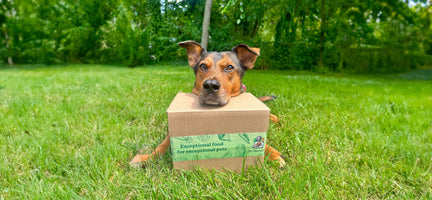As the leaves change and the air gets crisp, it’s the perfect time to introduce some seasonal foods into your dog’s diet. Fall is here, and so is a new variety of foods! Fall’s nutrient-packed foods can boost your pup’s health and add a bit of variety to their meals. Here are some fall superfoods that are safe and beneficial for dogs:
1. Pumpkin
Pumpkin is a fantastic source of fiber and beta-carotene, which converts to vitamin A. It aids digestion and can help alleviate diarrhea in your companion. Plus, most dogs love the taste!
How to Serve: You can mix pureed pumpkin into your dog’s regular food. You can also slice pumpkin, slightly cook it, and use it as treats. Avoid canned pumpkin pie filling, as it often contains added sugars and spices.
Pro Tip: Consider adding our Runs Be Done to your dog’s meals or homemade treats. This digestive supplement contains pumpkin and other beneficial ingredients like slippery elm, apple pectin, and bentonite clay.

2. Sweet Potatoes
Rich in vitamins A, B6, C, and E, sweet potatoes are great for your dog’s immune system and vision. They also provide a good amount of dietary fiber. Sweet potatoes can also be very beneficial to your dog's digestive tract.
How to Serve: Cook and mash sweet potatoes, then mix them into your dog’s meals. You can also slice them into thin pieces and bake them for a crunchy treat or use them as a topper on your pup's food.
3. Apples
Apples are high in fiber and vitamin C. They are low in fat, making them a great snack for dogs, especially those with low-fat dietary requirements. It is critical to remove the seeds and core before feeding apples to your dog because the seeds contain cyanide (a poisonous chemical).
How to Serve: Slice apples into bite-sized pieces and serve them as a crunchy snack. You can also mix apple slices with a bit of peanut butter for an extra special treat. Just be sure to use peanut butter that doesn’t contain any xylitol, as this can be toxic for dogs.
4. Carrots
Carrots are another excellent source of beta-carotene and fiber. They are great for your dog’s teeth, helping to prevent plaque build-up, and can be served raw or cooked.
How to Serve: Offer raw carrot sticks as a crunchy snack or cook and mix them into your dog’s food. Carrot pieces can also be frozen for a refreshing treat.

5. Beets
Beets are packed with fiber, vitamins, and phytochemicals that support healthy digestion and immune function. They can be served cooked and chopped into small pieces.
How to Serve: Cook and chop beets into small pieces before adding them to your dog’s meals. Keep in mind that fresh beets or frozen are best; canned and pickled can have added ingredients and preservatives.
6. Brussels Sprouts
These little green veggies are full of vitamins and antioxidants. They can help reduce inflammation and support overall health. Just make sure to cook them thoroughly to avoid any digestive upset.
How to Serve: Steam or boil brussels sprouts until they are soft, then chop them into small pieces. Avoid adding any seasoning or butter.
7. Cranberries
Cranberries are known for their urinary tract health benefits. They are rich in antioxidants and can be given fresh or dried (without added sugar).
How to Serve: Mix fresh cranberries into your dog’s food or bake them into homemade treats. Ensure there are no added sugars or preservatives. These are best given in small quantities. Avoid cranberry sauce as it is high in sugar, which can cause gastrointestinal upset, and some recipes include grapes, raisins, or currants, which are toxic to dogs.
8. Kale
Leafy greens are just as healthy for dogs as for people. They are rich in vitamins A, C, and K, calcium, iron, and potassium. Leafy greens are also a good source of fiber. Some of the best ones for dogs are kale and spinach.
How to Serve: Chop kale into small pieces and mix it into your dog’s meals. You can also lightly steam it to make it easier to digest if needed.

How to Incorporate These Superfoods
You can add these superfoods to your dog’s regular meals or use them as healthy treats. Always introduce new foods gradually and in moderation to avoid any digestive upset. And, as always, consult with your veterinarian before making any significant changes to your dog’s diet.
Recipe Ideas:
- Pumpkin and Sweet Potato Mash Lick Plate: Combine cooked pumpkin and sweet potatoes for a nutrient-rich mash, then spread it on a lick mat for a fun, engaging activity.
- Apple and Carrot Crunchies Dog Treat Dispenser: Mix sliced apples and carrots for a crunchy treat and add them to a doggy treat dispenser to make an engaging game.
Embrace the season and give your pup a nutritional boost with these fall superfoods. They’ll love the variety, and you’ll love knowing you’re supporting their health! Seasonal fruits and vegetables are not only a great way to keep your dog's diet interesting, but they also offer a range of health benefits that can keep your pup happy and healthy all season long.

Can I give my dog raw pumpkin?
Yes, you can give your dog raw pumpkin, but most dogs prefer it cooked or pureed. Raw pumpkin can be harder for some dogs to digest.
How much sweet potato should I give my dog?
Moderation is key. A few spoonfuls mixed with their regular food or a couple of slices as a treat are usually sufficient.
Are there any fruits and vegetables I should avoid giving my dog?
Yes, avoid giving your dog grapes, raisins, and onions, as they can be toxic to dogs.
Can I use frozen vegetables and fruits instead of fresh?
Yes, frozen vegetables can be a good alternative to fresh ones. Just make sure they are plain and without added sauces or seasonings.
How should I introduce these superfoods to my dog’s diet?
Introduce new foods gradually and in small amounts to monitor for any adverse reactions. Always consult with your veterinarian before making significant changes to your dog's diet.
Can I mix multiple superfoods together in one meal?
Yes, you can mix multiple superfoods together. Just ensure you introduce them slowly and in moderation to avoid any digestive issues.






